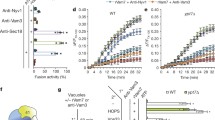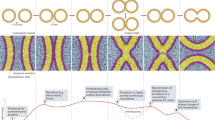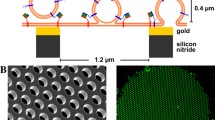Abstract
The assembly of SNARE proteins into a tight complex has been hypothesized to drive membrane fusion. A model of the initial fusion pore as a proteinaceous channel formed by SNARE proteins places their membrane anchors in separate membranes. This leaves the possibility of a final assembly step that brings the membrane anchors together and drives fusion pore expansion. The present study develops a model for expansion in which the final SNARE complex zipping step drives a transition from a proteinaceous fusion pore to a lipidic fusion pore. An estimate of the energy released upon merger of the helical segments of the SNARE motifs with the helical segments of the membrane anchors indicates that completing the assembly of a few SNARE complexes can overcome the elastic energy that opposes lipid bilayer deformation into a narrow fusion pore. The angle between the helical axes of the membrane anchor and SNARE motif serves as a useful reaction coordinate for this transition. Energy was calculated as a function of this angle, incorporating contributions from membrane bending, SNARE complex assembly, membrane anchor flexing and hydrophobic interactions. The rate of this transition was evaluated as a process of diffusion over the barrier imposed by these combined energies, and the rates estimated were consistent with experimental measurements.




Similar content being viewed by others
References
Baldwin RL (2007) Energetics of protein folding. J Mol Biol 371:283–301
Boal D (2002) Mechanics of the cell. Cambridge University Press, Cambridge
Brunger AT (2005) Structure and function of SNARE and SNARE-interacting proteins. Q Rev Biophys 38:1–47
Chernomordik LV, Kozlov MM (2003) Protein–lipid interplay in fusion and fission of biological membranes. Annu Rev Biochem 72:175–207
Chicka MC, Hui E, Liu H, Chapman ER (2008) Synaptotagmin arrests the SNARE complex before triggering fast, efficient membrane fusion in response to Ca2+. Nat Struct Mol Biol 15:827–835
Chizmadzhev YA, Cohen FS, Shcherbakov A, Zimmerberg J (1995) Membrane mechanics can account for fusion pore dilation in stages. Biophys J 69:2489–2500
Chizmadzhev YA, Kumenko DA, Kuzmin PI, Chernomordik LV, Zimmerberg J, Cohen FS (1999) Lipid flow through fusion pores connecting membranes of different tensions. Biophys J 76:2951–2965
Chizmadzhev YA, Kuzmin PI, Kumenko DA, Zimmerberg J, Cohen FS (2000) Dynamics of fusion pores connecting membranes of different tensions. Biophys J 78:2241–2256
Choe S, Sun SX (2005) The elasticity of alpha-helices. J Chem Phys 122:244912
Dill KA, Truskett TM, Vlachy V, Hribar-Lee B (2005) Modeling water, the hydrophobic effect, and ion solvation. Annu Rev Biophys Biomol Struct 34:173–199
Domanska MK, Kiessling V, Stein A, Fasshauer D, Tamm LK (2009) Single vesicle millisecond fusion kinetics reveals number of SNARE complexes optimal for fast SNARE-mediated membrane fusion. J Biol Chem 284:32158–32166
Fang Q, Berberian K, Gong LW, Hafez I, Sorensen JB, Lindau M (2008) The role of the C terminus of the SNARE protein SNAP-25 in fusion pore opening and a model for fusion pore mechanics. Proc Natl Acad Sci USA 105:15388–15392
Fasshauer D (2003) Structural insights into the SNARE mechanism. Biochim Biophys Acta 1641:87–97
Ferro-Novick S, Jahn R (1994) Vesicle fusion from yeast to man. Nature 370:191–193
Han X, Jackson MB (2005) Electrostatic interactions between the syntaxin membrane anchor and neurotransmitter passing through the fusion pore. Biophys J 88:L20–L22
Han X, Jackson MB (2006) Structural transitions in the synaptic SNARE complex during Ca2+-triggered exocytosis. J Cell Biol 172:281–293
Han X, Wang CT, Bai J, Chapman ER, Jackson MB (2004) Transmembrane segments of syntaxin line the fusion pore of Ca2+-triggered exocytosis. Science 304:289–292
Hanson PI, Heuser JE, Jahn R (1997) Neurotransmitter release—four years of SNARE complexes. Curr Opin Neurobiol 7:310–315
Harbury PA (1998) Springs and zippers: coiled coils in SNARE-mediated membrane fusion. Structure 6:1487–1491
Harrington WF, Rodgers ME, Davis JS (1990) Functional aspects of the myosin rod in muscle contraction. In: Squire JW (ed) Molecular mechanisms in muscular contraction. Macmillan, London, pp 241–257
Hristova K, White SH (1998) Determination of the hydrocarbon core structure of fluid dioleoylphosphocholine (DOPC) bilayers by X-ray diffraction using specific bromination of the double-bonds: effect of hydration. Biophys J 74:2419–2433
Hua SY, Charlton MP (1999) Activity-dependent changes in partial VAMP complexes during neurotransmitter release. Nat Neurosci 2:1078–1083
Hua Y, Scheller RH (2001) Three SNARE complexes cooperate to mediate membrane fusion. Proc Natl Acad Sci USA 98:8065–8070
Jackson MB (2006) Molecular and cellular biophysics. Cambridge University Press, Cambridge
Jackson MB (2009) Minimum membrane bending energies of fusion pores. J Membr Biol 231:101–115
Jackson MB, Chapman ER (2006) Fusion pores and fusion machines in Ca2+-triggered exocytosis. Annu Rev Biophys Biomol Struct 35:135–160
Jahn R, Scheller RH (2006) SNAREs—engines for membrane fusion. Nat Rev Mol Cell Biol 7:631–643
Katsov K, Muller M, Schick M (2004) Field theoretic study of bilayer membrane fusion. I. Hemifusion mechanism. Biophys J 87:3277–3290
Kesavan J, Borisovska M, Bruns D (2007) v-SNARE actions during Ca2+-triggered exocytosis. Cell 131:351–363
Kozlov MM, Leikin SL, Chernomordik LV, Markin VS, Chizmadzhev YA (1989) Stalk mechanism of vesicle fusion. Intermixing of aqueous contents. Eur Biophys J 17:121–129
Kozlovsky Y, Kozlov MM (2002) Stalk model of membrane fusion: solution of energy crisis. Biophys J 82:882–895
Kramers HA (1940) Brownian motion in a field of force. Physica 7:284–304
Kuzmin PI, Zimmerberg J, Chizmadzhev YA, Cohen FS (2001) A quantitative model for membrane fusion based on low-energy intermediates. Proc Natl Acad Sci USA 98:7235–7240
Kweon DH, Kim CS, Shin YK (2002) The membrane-dipped neuronal SNARE complex: a site-directed spin labeling electron paramagnetic resonance study. Biochemistry 41:9264–9268
Kweon DH, Kim CS, Shin YK (2003) Insertion of the membrane-proximal region of the neuronal SNARE coiled coil into the membrane. J Biol Chem 278:12367–12373
Lam AD, Tryoen-Toth P, Tsai B, Vitale N, Stuenkel EL (2008) SNARE-catalyzed fusion events are regulated by syntaxin1a–lipid interactions. Mol Biol Cell 19:485–497
Lee J, Lentz BR (1997) Evolution of lipidic structures during model membrane fusion and the relation of this process to cell membrane fusion. Biochemistry 36:6251–6259
Lewis BA, Engelman DM (1983) Lipid bilayer thickness varies linearly with acyl chain length in fluid phosphatidylcholine vesicles. J Mol Biol 166:211–217
Lindau M, Almers W (1995) Structure and function of fusion pores in exocytosis and ectoplasmic membrane fusion. Curr Opin Cell Biol 7:509–517
MacCallum JL, Moghaddam MS, Chan HS, Tieleman DP (2007) Hydrophobic association of alpha-helices, steric dewetting, and enthalpic barriers to protein folding. Proc Natl Acad Sci USA 104:6206–6210
Markin VS, Albanesi JP (2002) Membrane fusion: stalk model revisited. Biophys J 82:693–712
McNew JA, Weber T, Engelman DM, Sollner TH, Rothman JE (1999) The length of the flexible SNAREpin juxtamembrane region is a critical determinant of SNARE-dependent fusion. Mol Cell 4:415–421
McNew JA, Weber T, Parlati F, Johnston RJ, Melia TJ, Sollner TH, Rothman JE (2000) Close is not enough: SNARE-dependent membrane fusion requires an active mechanism that transduces force to membrane anchors. J Cell Biol 150:105–117
Melia TJ, Weber T, McNew JA, Fisher LE, Johnston RJ, Parlati F, Mahal LK, Sollner TH, Rothman JE (2002) Regulation of membrane fusion by the membrane-proximal coil of the t-SNARE during zippering of SNAREpins. J Cell Biol 158:929–940
Meyer EE, Rosenberg KJ, Israelachvili J (2006) Recent progress in understanding hydrophobic interactions. Proc Natl Acad Sci USA 103:15739–15746
Montecucco C, Schiavo G, Pantano S (2005) SNARE complexes and neuroexocytosis: how many, how close? Trends Biochem Sci 30:367–372
Parsegian VA, Fuller N, Rand RP (1979) Measured work of deformation and repulsion of lecithin bilayers. Proc Natl Acad Sci USA 76:2750–2754
Poirier MA, Xiao W, Macosko JC, Chan C, Shin YK, Bennett MK (1998a) The synaptic SNARE complex is a parallel four-stranded helical bundle. Nat Struct Biol 5:765–769
Poirier MA, Hao JC, Malkus PN, Chan C, Moore MF, King DS, Bennett MK (1998b) Protease resistance of syntaxin.SNAP-25.VAMP complexes. Implications for assembly and structure. J Biol Chem 273:11370–11377
Reynolds JA, Gilbert DB, Tanford C (1974) Empirical correlation between hydrophobic free energy and aqueous cavity surface area. Proc Natl Acad Sci USA 71:2925–2927
Richards FM (1977) Areas, volumes, packing and protein structure. Annu Rev Biophys Bioeng 6:151–176
Rose GD, Geselowitz AR, Lesser GJ, Lee RH, Zehfus MH (1985) Hydrophobicity of amino acid residues in globular proteins. Science 229:834–838
Rothman JE (1994) Intracellular membrane fusion. Adv Second Messenger Phosphoprotein Res 29:81–96
Sharp KA, Nicholls A, Fine RF, Honig B (1991) Reconciling the magnitude of the microscopic and macroscopic hydrophobic effects. Science 252:106–109
Sorensen JB, Wiederhold K, Muller EM, Milosevic I, Nagy G, de Groot BL, Grubmuller H, Fasshauer D (2006) Sequential N- to C-terminal SNARE complex assembly drives priming and fusion of secretory vesicles. EMBO J 25:955–966
Stein A, Weber G, Wahl MC, Jahn R (2009) Helical extension of the neuronal SNARE complex into the membrane. Nature 460:525–528
Sutton RB, Fassauer D, Jahn R, Brunger AT (1998) Crystal structure of a SNARE complex involved in synaptic exocytosis at 2.4 Å resolution. Nature 395:347–353
Tanford C (1979) Interfacial free energy and the hydrophobic effect. Proc Natl Acad Sci USA 76:4175–4176
Tanford C (1980) The hydrophobic effect. Wiley, New York
Wang CT, Bai J, Chang PY, Chapman ER, Jackson MB (2006) Synaptotagmin-Ca2+ triggers two sequential steps in regulated exocytosis in rat PC12 cells: fusion pore opening and fusion pore dilation. J Physiol 570:295–307
Wojcik J, Altmann K-H, Scheraga HA (1990) Helix-coil stability constants for the naturally occurring amino acids in water. XXIV. Half-cystine parameters from random poly9hydroxybutylglutamine-co-Smethylthio-L-cysteine. Biopolymers 30:121–134
Xu T, Rammner B, Margittai M, Artalejo AR, Neher E, Jahn R (1999) Inhibition of SNARE complex assembly differentially affects kinetic components of exocytosis. Cell 99:713–722
Zhang Z, Jackson MB (2010) Membrane bending energy and fusion pore kinetics in Ca2+-triggered exocytosis. Biophys J (in press)
Zhang Z, Zhang Z, Jackson MB (2010) Synaptotagmin IV modulation of vesicle size and fusion pores in PC12 cells. Biophys J 98:968–978
Zimm BH, Bragg JK (1959) Theory of the phase transition between helix and random coil in polypeptide chains. J Chem Phys 31:526–535
Zimmerberg J, Kozlov MM (2006) How proteins produce cellular membrane curvature. Nat Rev Mol Cell Biol 7:9–19
Acknowledgements
I thank Fred Cohen, Ed Chapman, Jim Weisshaar, Qiang Cui and Tom Record for helpful discussions and comments. This work was funded by NIH grant NS44057.
Author information
Authors and Affiliations
Corresponding author
Rights and permissions
About this article
Cite this article
Jackson, M.B. SNARE Complex Zipping as a Driving Force in the Dilation of Proteinaceous Fusion Pores. J Membrane Biol 235, 89–100 (2010). https://doi.org/10.1007/s00232-010-9258-1
Received:
Accepted:
Published:
Issue Date:
DOI: https://doi.org/10.1007/s00232-010-9258-1




